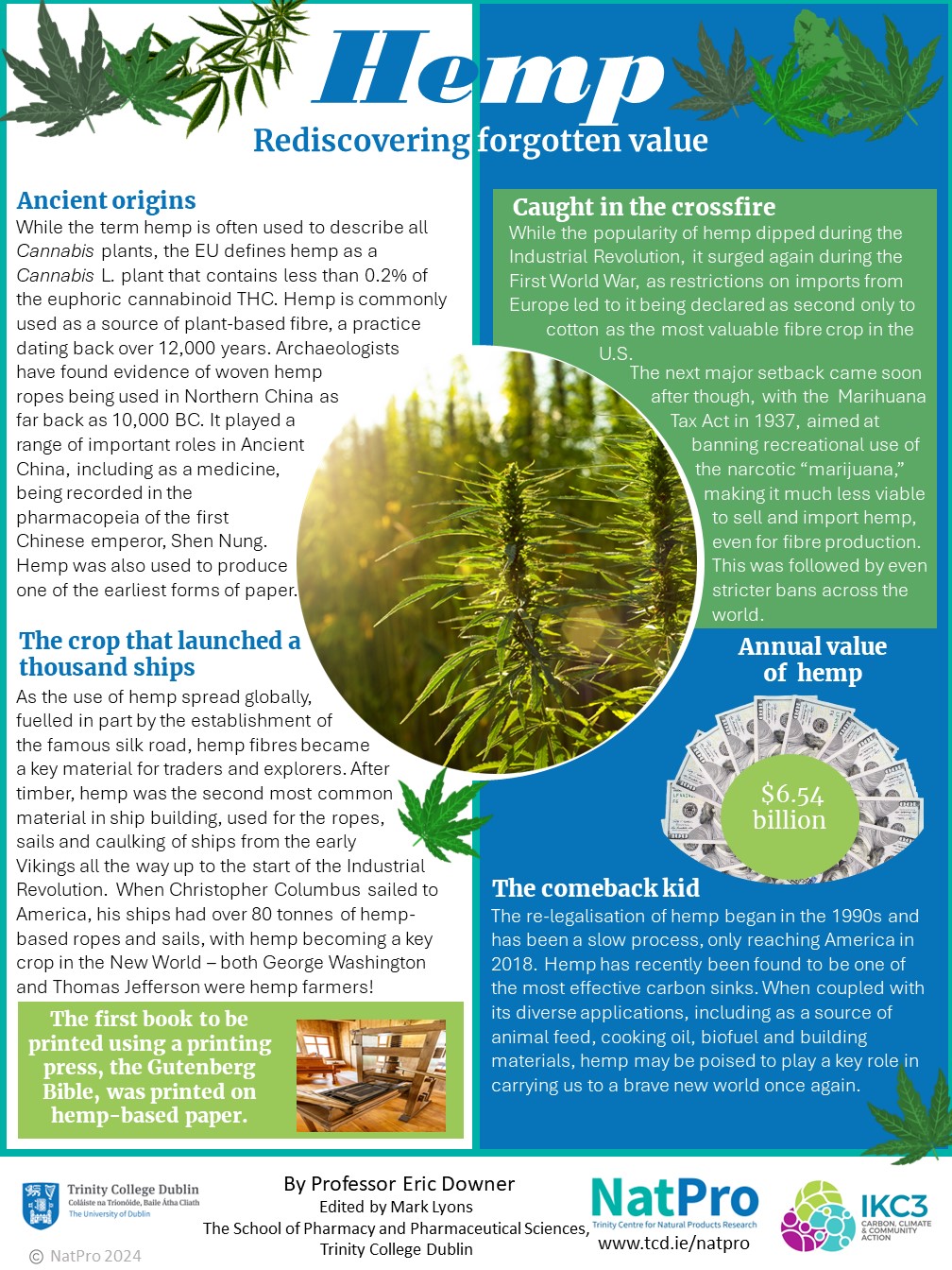Nature's Treasure Trove
20th May 2024
NatPro, Trinity’s Centre for Natural Product Research at Trinity College Dublin, is pleased to launch the ‘Nature's Treasure Trove’ innovative infographic series running over seven weeks to educate and engage people on the significant contributions of natural products to various sectors, including medicine, food production, and cosmetics.
We will take you on a journey from the sea to the land, from Egypt to the bogs of Ireland, as we explore themes such as 'Nature’s Pharmacy', 'Waves of Opportunity', 'Building a Bioeconomy', and 'Life’s Guilty Pleasures'. This series will highlight familiar and impactful examples from nature, looking at their earliest roots to their modern-day impact and new innovations.
The series aims not only to raise awareness but also to foster a deeper understanding and appreciation of natural products and their roles in our daily lives.
Nature’s Pharmacy
Theme One
The first theme we are exploring as part of our ‘Nature's Treasure Trove’ infographic series is 'Nature’s Pharmacy'! This exciting theme delves into how natural compounds have played a pivotal role in transforming healthcare and medicine. Over the centuries, nature has provided an abundant source of medicinal substances that have saved countless lives and improved the quality of health worldwide.
This week, we will focus on three remarkable examples that illustrate the profound impact of natural compounds on modern medicine. First, we'll explore the story of penicillin. Discovered by Alexander Fleming in 1928, penicillin is often hailed as one of the greatest advancements in medical history. This powerful antibiotic, derived from the Penicillium mould, has revolutionised the treatment of bacterial infections and has saved millions of lives since its introduction.
Next, we will examine aspirin, another cornerstone of modern medicine. Derived from the bark of the willow tree, aspirin has been used for centuries as a pain reliever and anti-inflammatory agent. Its discovery and development into the drug we know today is a fascinating journey that showcases nature's incredible ability to provide effective remedies for various ailments.
Finally, we will highlight lovastatin, a groundbreaking compound in the fight against cardiovascular disease. Lovastatin, a natural statin found in fungi, has significantly lowered cholesterol levels and reduced the risk of heart disease for millions of people.
Through these examples, we aim to shed light on the incredible potential of nature's pharmacy and its ongoing contributions to healthcare.
Penicillin - An antimicrobial miracle
Discover the fascinating journey of penicillin, an antimicrobial miracle that revolutionised medicine. From its serendipitous discovery by Alexander Fleming in 1928 to its life-saving role during World War II, this infographic explores the impact and ongoing challenges of this remarkable antibiotic.
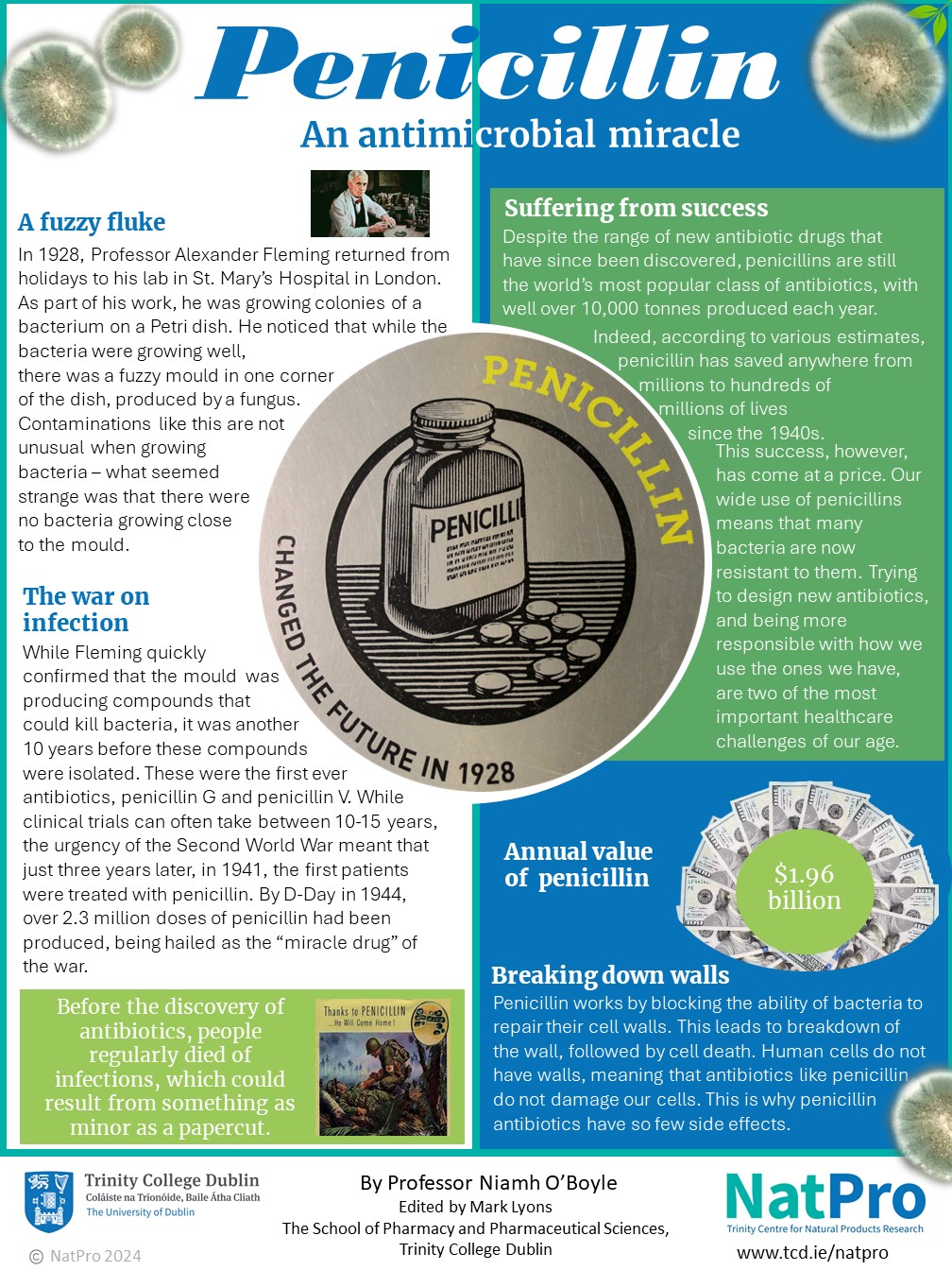
Dr. Niamh O'Boyle is an Associate Professor at Trinity College Dublin, specialising in Pharmaceutical Chemistry. Her research focuses on drug development for hard-to-treat cancers and skin allergy mechanisms. Supported by various prestigious grants, she actively publishes in peer-reviewed journals and holds two patents. She is passionate about outreach and education.
Annual value source here
Image sources
- Center image 1928 PENICILLIN from Leo Reynolds
- Image of Professor Alexander Fleming via Encyclopædia Britannica
- WW2 Aadvertisement for penicillin production from Life magazine, August 14, 1944
Lovastain - A fungal fortune
Lovastatin, from moulds to a heart health revolution, lovastatin's journey showcases the power of natural compounds in modern medicine. Celebrate this remarkable advancement in lowering cholesterol.
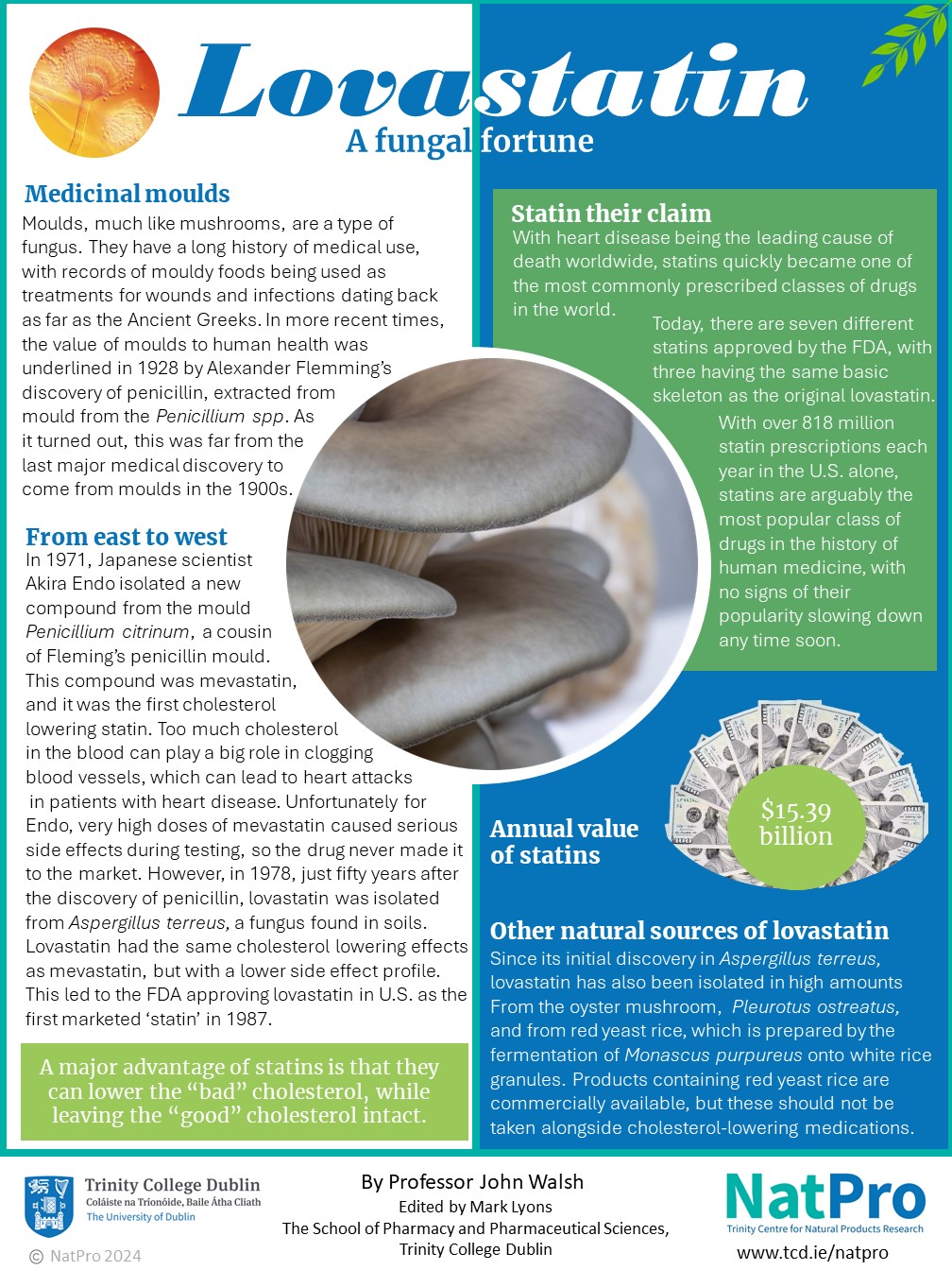
Professor John J. Walsh,Associate Acadaemic Director, NatPro, holds a BA and PhD from TCD. Joining the School of Chemistry in 1997, he leads drug design programmes for cancer, malaria, and allergies. He has secured funding from multiple sources, published extensively, supervised numerous students, and served as an external examiner. John advocates for research-led teaching and holds several patents.
Annual value source here
Aspirin - Nature’s cure for a broken heart
Aspirin is fascinating due to its ancient roots, dating back over 4,000 years when cultures like the Celts and Greeks used willow bark for pain relief. Beyond pain relief, aspirin reduces inflammation, prevents blood clots, and manages heart conditions. Learn more about its origins and why it has become one of the most versatile and important drugs in modern medicine.
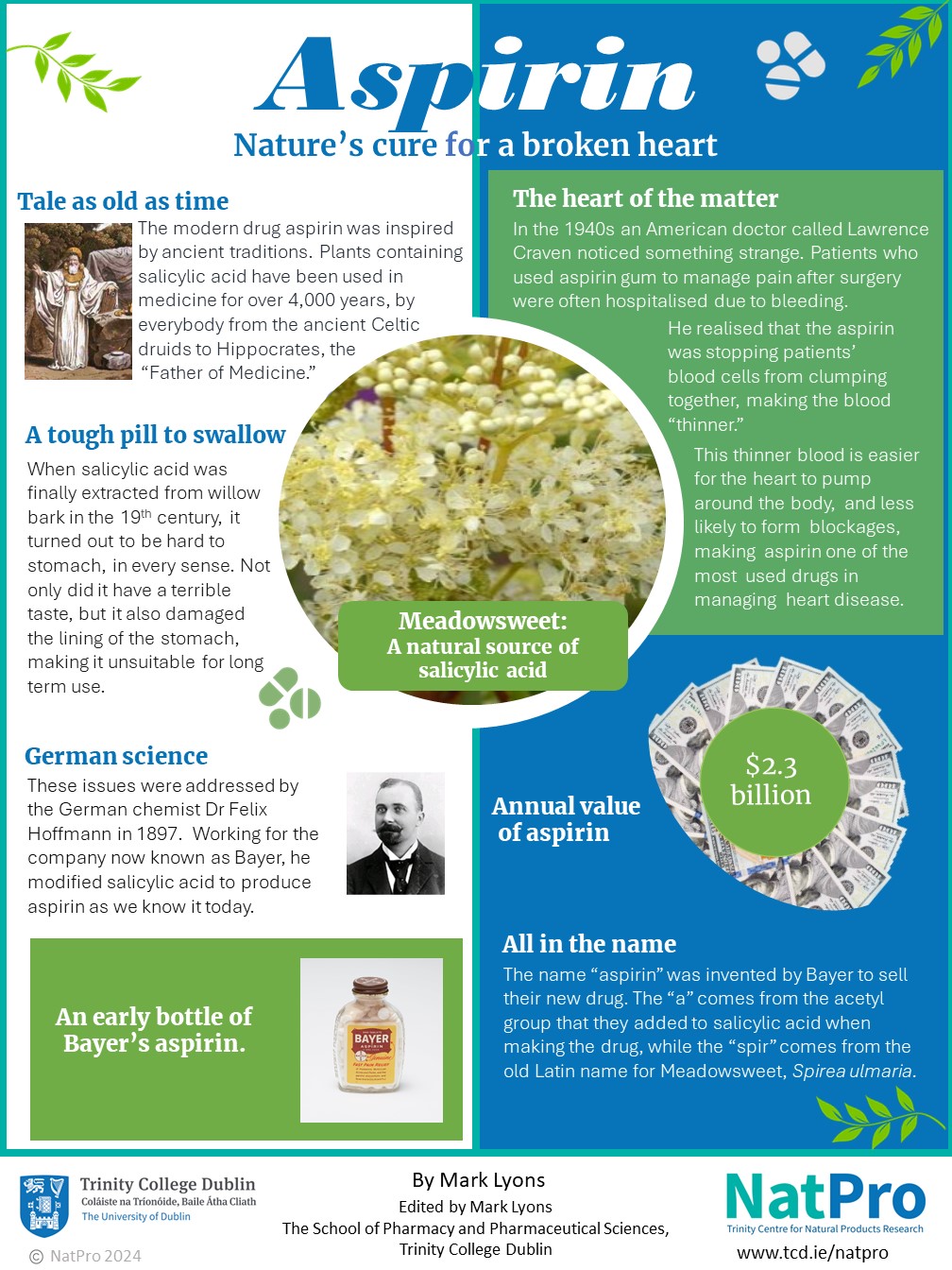
By Mark Lyons
Mark Lyons is a Panoz Pharmaceutical Innovation PhD Scholar, currently in the third year of his PhD at the School of Pharmacy and Pharmaceutical Science at Trinity College Dublin. He completed his undergraduate in the school of Pharmacy at Trinity in 2021 and is a registered pharmacist.
Annual value source here
Image sources
- Druid image from Cassell’s History of England, Vol. I unknown artists
- Image of Dr Felix Hottmann via Bayer // Global
- Image of Bayer Asprin bottle courtesy of Science History Institute
Life’s Guilty Pleasures
Theme Two
The second theme we are exploring as part of our ‘Nature's Treasure Trove’ infographic series is 'Life’s Guilty Pleasures'! This delightful theme highlights how some of our favourite indulgences not only bring joy but also offer surprising health benefits. Over centuries, coffee, chocolate, and red wine have become beloved staples in many cultures, celebrated for their rich flavours and complex histories.
This week, we will focus on these three indulgences that illustrate the remarkable intersection of pleasure and health. First, we'll delve into the world of coffee. Legend has it that an Ethiopian goatherd named Kaldi discovered coffee when he noticed his goats dancing after eating red berries. From these humble beginnings, coffee has become a global phenomenon, offering not just a caffeine kick but also potential benefits in reducing the risk of diseases like type 2 diabetes and Parkinson’s.
Next, we will savour the story of chocolate. Originating over 3,600 years ago with the Olmecs and later revered by the Mayans and Aztecs as the “Food of the Gods,” chocolate has transformed from a bitter, spiced drink into the sweet treat we enjoy today. Dark chocolate, in particular, is rich in antioxidants and has been linked to improved heart health and enhanced mood.
Finally, we will raise a glass to red wine. With origins dating back to 6,000 BC in modern-day Georgia, red wine has been celebrated by ancient civilizations and linked to religious rituals. The “French Paradox” in the 1990s suggested that moderate red wine consumption might explain France's low heart disease rates despite a rich diet. Compounds in red wine, like resveratrol, are believed to offer cardiovascular benefits, making it a delightful and potentially healthy indulgence.
Through these examples, we aim to showcase how life’s guilty pleasures, rooted in nature, can offer both enjoyment and health benefits.
Coffee - A cup of magical beans
Ever wonder why coffee makes you feel like you can conquer the world? Legend has it that a goatherd named Kaldi discovered coffee when he saw his goats dancing around after eating some red berries. From keeping Yemeni Sufis awake during prayers to being declared halal and spreading across the globe, coffee has a storied past. And guess what? Modern research says it might even help with type 2 diabetes and Parkinson’s!
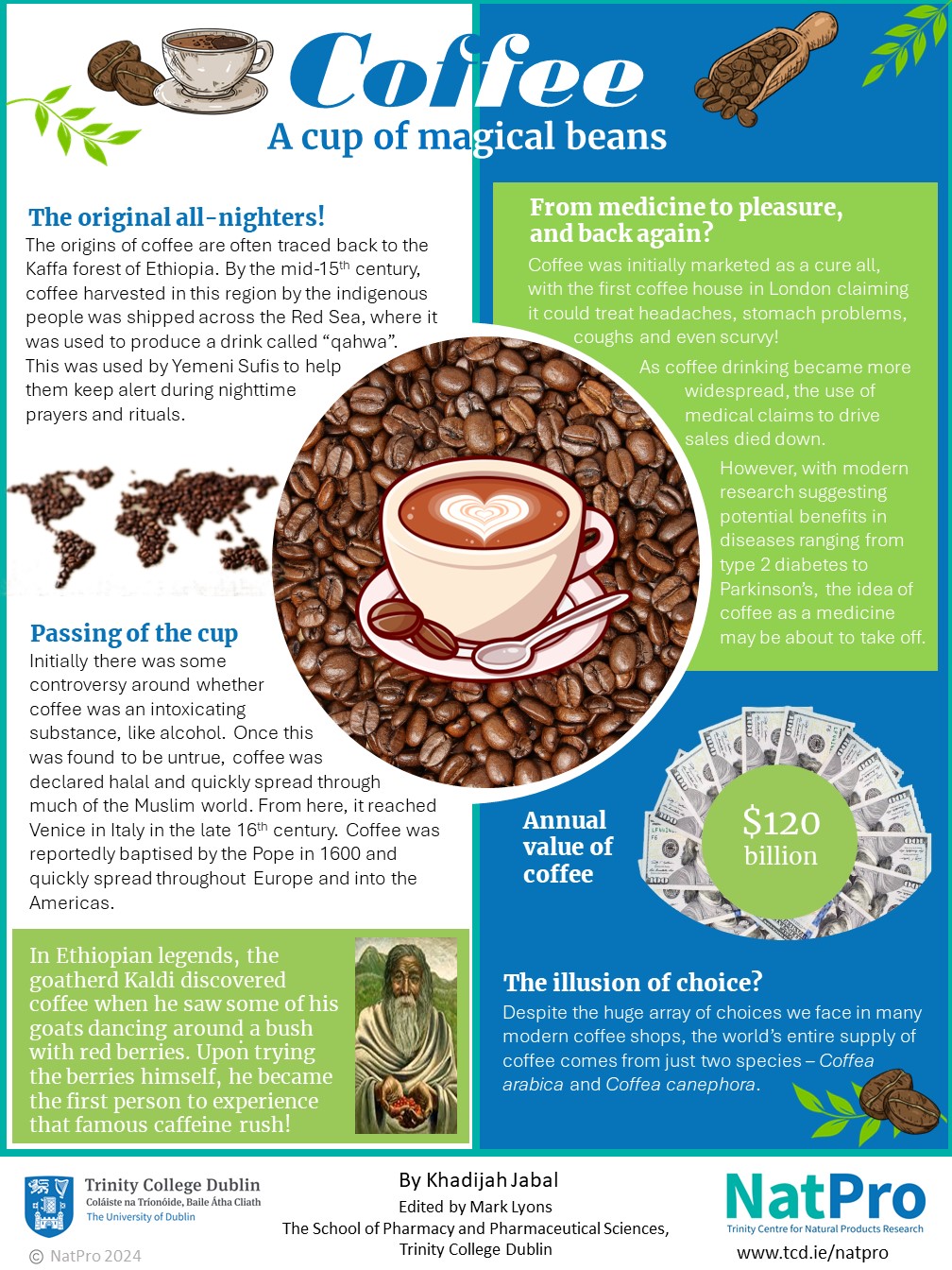
Khadijah Jabal is a postgradute student at the School of Pharmacy and Pharmaceutical Science at Trinity College Dublin supervised by Professor John Walsh.
Annual value source here
Image sources
- Image source of Kaldi from EHL unknown artists
Chocolate - A sweet antidote for life's bitter moments
Discover the fascinating history and surprising health benefits of chocolate in this week's 'Nature's Treasure Trove'. From ancient Mesoamerican rituals to modern sweet indulgences, explore how chocolate has delighted and benefited humanity for over 3,600 years.
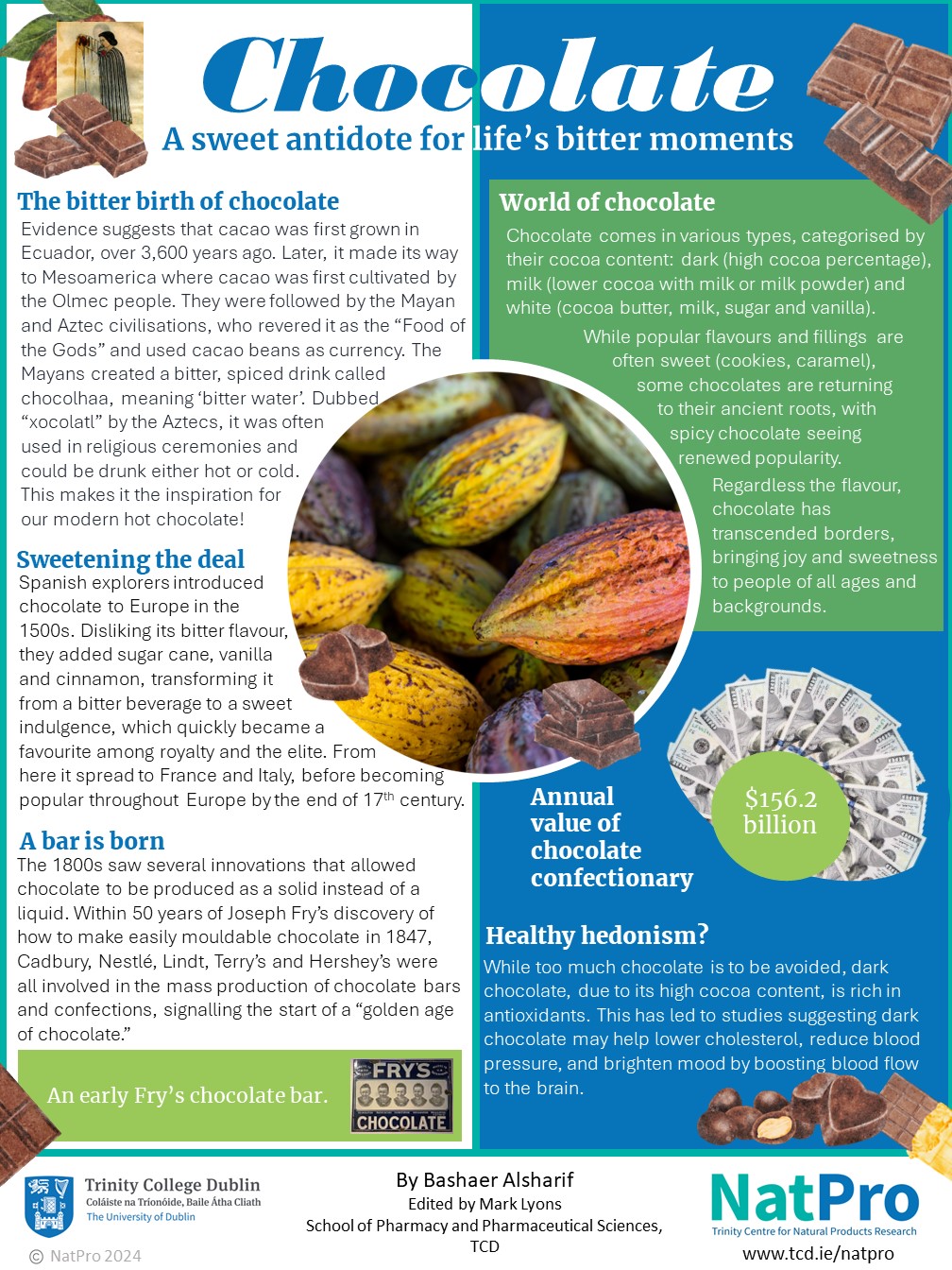
Bashaer Alsharif is a postgradute student at the School of Pharmacy and Pharmaceutical Science at Trinity College Dublin suprvised by Professor Fabio Boylan.
Annual value source here
Image sources
- Image source of Kaldi from Wikipedia Enamel sign advertising Fry's Chocolate, pre-1925
Red wine - More than just a glass of juice
Discover the intriguing history and surprising health benefits of red wine in this week's 'Nature's Elixirs'. From ancient religious ceremonies to modern health studies, explore how red wine has enriched and benefited humanity for thousands of years.
Excessive alcohol intake can lead to serious health issues, including liver disease, heart problems, and addiction. Pregnant women, individuals with certain medical conditions, or those taking specific medications should avoid alcohol. Always drink in moderation.
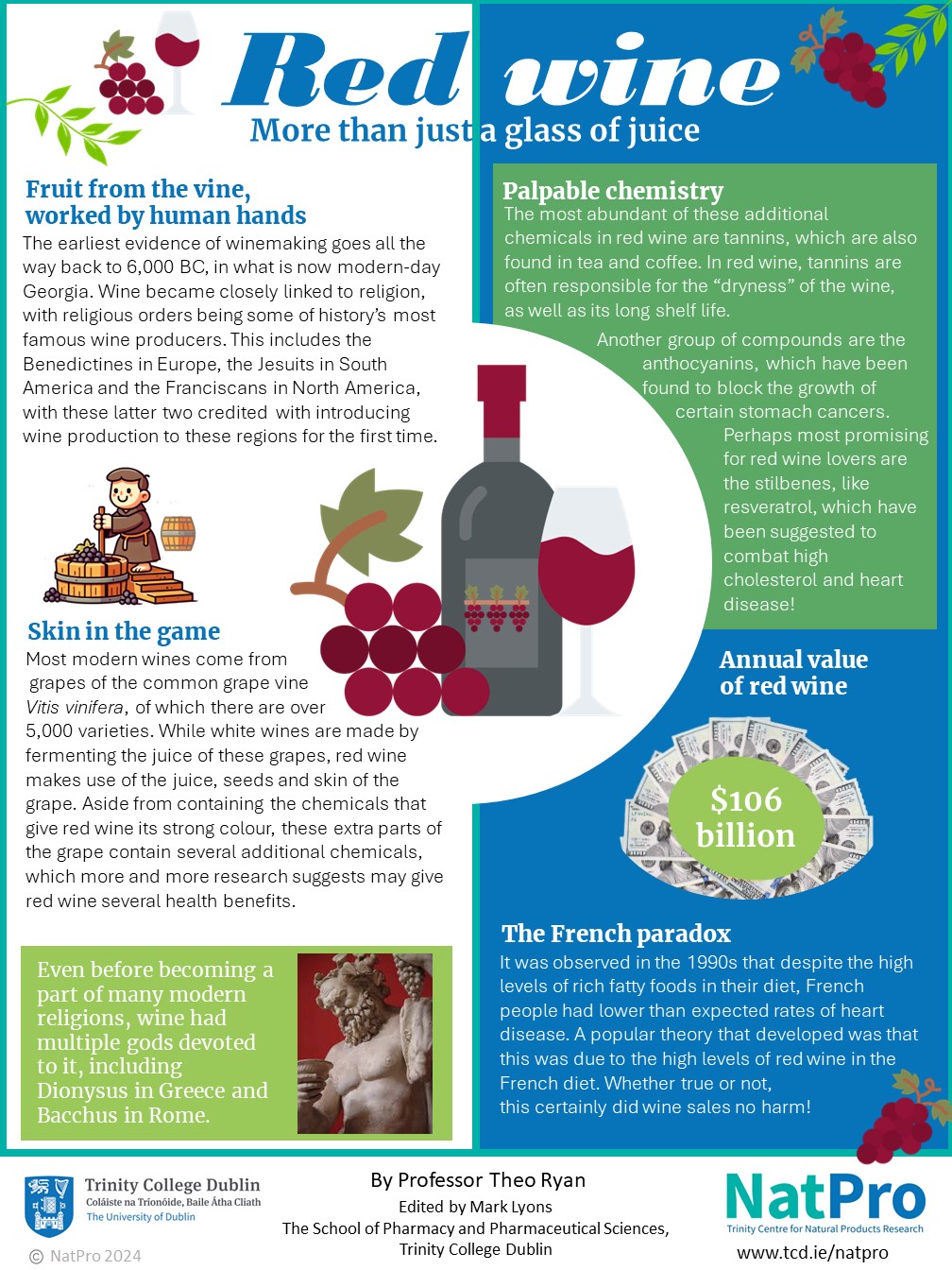
Professor Theo Ryan is a registered practising pharmacist, dividing his time between the School and community pharmacy. He holds a B.A. and Ph.D. from Trinity College Dublin, and an M.Pharm from the Royal College of Surgeons in Ireland. His research focuses on Pharmacy Practice, medication safety, and pedagogical development
Annual value source here
Image sources
- Image source of Bacchus from Wikipedia Bacchus im vatikanischen Museum
Waves of Opportunity
Theme Three
The third theme in our ‘Nature's Treasure Trove’ infographic series is 'Waves of Opportunity'! This theme uncovers marine resources with vast potential for innovation and human benefit.
First, we explore marine invertebrates. These creatures, covering over half of all life on Earth, are a treasure trove of bioactive compounds. For example, cone snail venom has led to powerful painkillers, and sponges have inspired novel cancer treatments.
Next, we dive into carrageenan. Extracted from red seaweed, carrageenan has been used since 600 BC for food thickening. Today, it’s a staple in food production, pharmaceuticals, and household products.
Finally, we examine microalgae. With over 40,000 species, these organisms have applications in sustainable food production, renewable energy, and medicine. Historically used by the Aztecs, microalgae are now researched for their potential in various innovative fields.
Through these examples, we aim to showcase how the ocean’s resources, rooted in nature, can offer both practical benefits and innovative solutions.
Invertebrates - Sponges, snails and science
Marine invertebrates, which thrive in the vast expanse of our oceans, are a treasure trove of astonishing bioactive compounds. These remarkable spineless creatures, constituting 92% of marine biodiversity, hold the key to groundbreaking medical advancements. Imagine the venom of the slow-moving cone snail, harbouring conotoxins that have revolutionised pain management with painkillers far more potent than morphine. Or consider the humble sponge, whose simple structure has led to the discovery of novel cancer treatments and antiviral drugs. The extraordinary diversity of these marine organisms highlights their crucial role in the quest for new and effective medicines, making the ocean a true wellspring of opportunity.
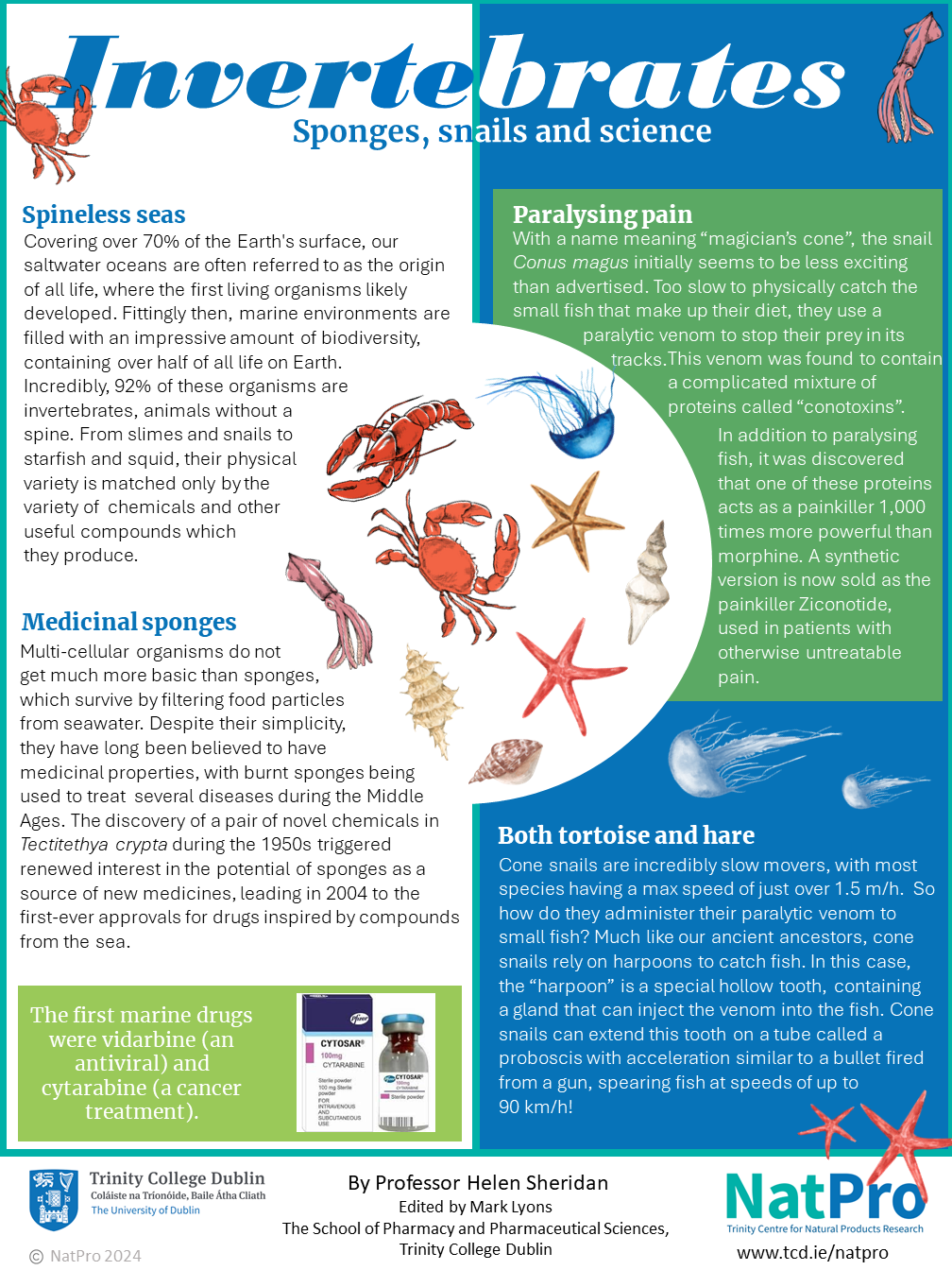
Helen Sheridan BSc, Professor in Pharmacognosy at Trinity College Dublin (TCD). Director of NatPro, Trinity Centre for Natural Products Research. With over 100 publications and €19 million in grants, she advances new therapies through interdisciplinary research in natural product chemistry.
Carrageenan - Nature's gift to foood formulation
From its origins in 600 BC China to its discovery in 5th century Ireland, carrageenan has become a vital thickening agent in numerous products. Beyond food, it clarifies beer, binds toothpaste, and serves the pharmaceutical industry. Explore its fascinating journey and modern applications.
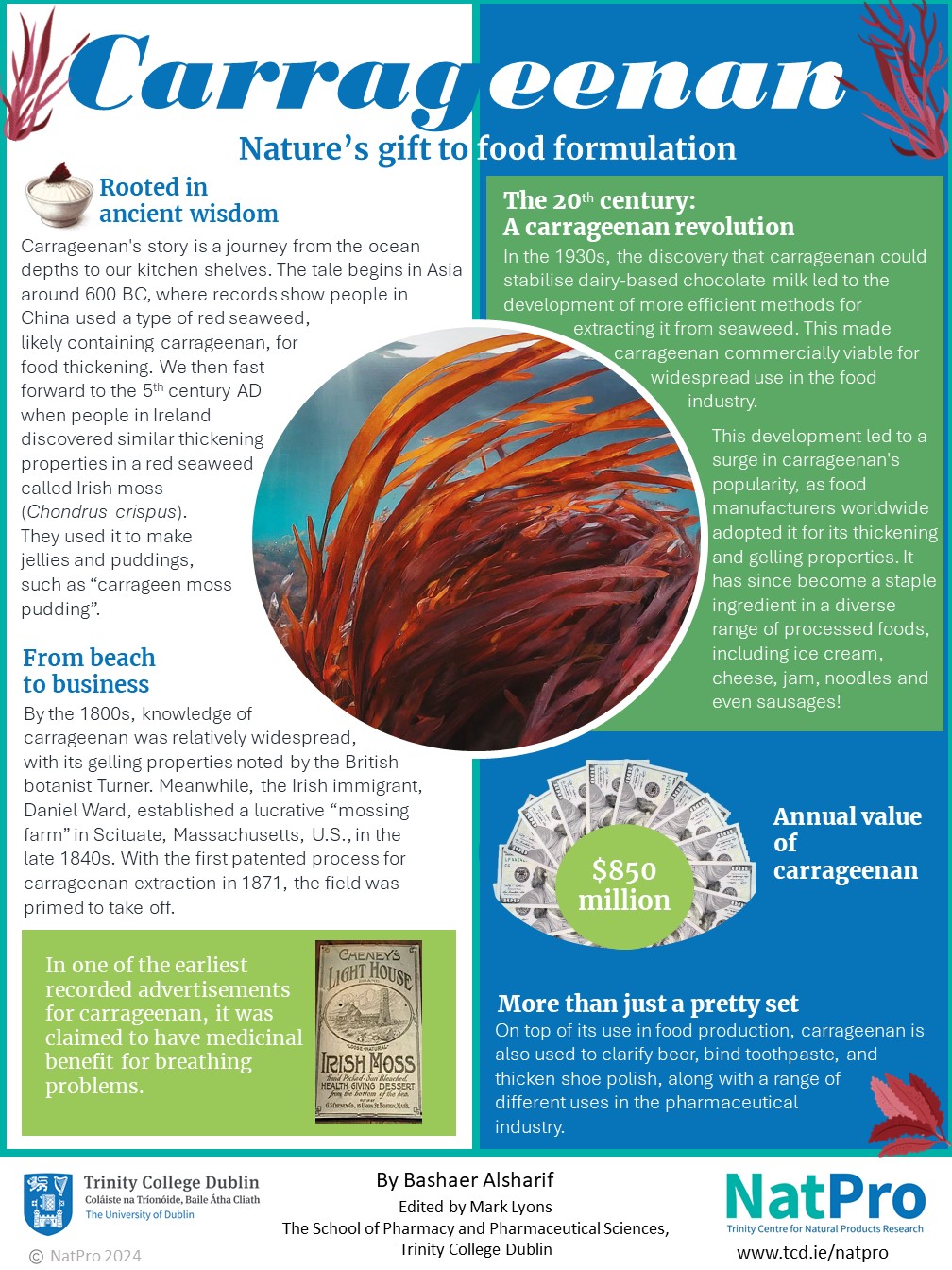
Bashaer Alsharif is a postgradute student under the supervision of Professor Fabio Boylan, Associate Acadaemic Director, NatPro, in the School of Pharmacy and Pharmaceutical Sciences in Trinity College Dublin
Annual value source here
Image sources
- Image source of Bacchus from Smithsonian Early advertisement for sea mossr
Microalgae - Medicine, food and Hitchcock
From its origins in 600 BC China to its discovery in 5th century Ireland, carrageenan has become a vital thickening agent in numerous products. Beyond food, it clarifies beer, binds toothpaste, and serves the pharmaceutical industry. Explore its fascinating journey and modern applications.
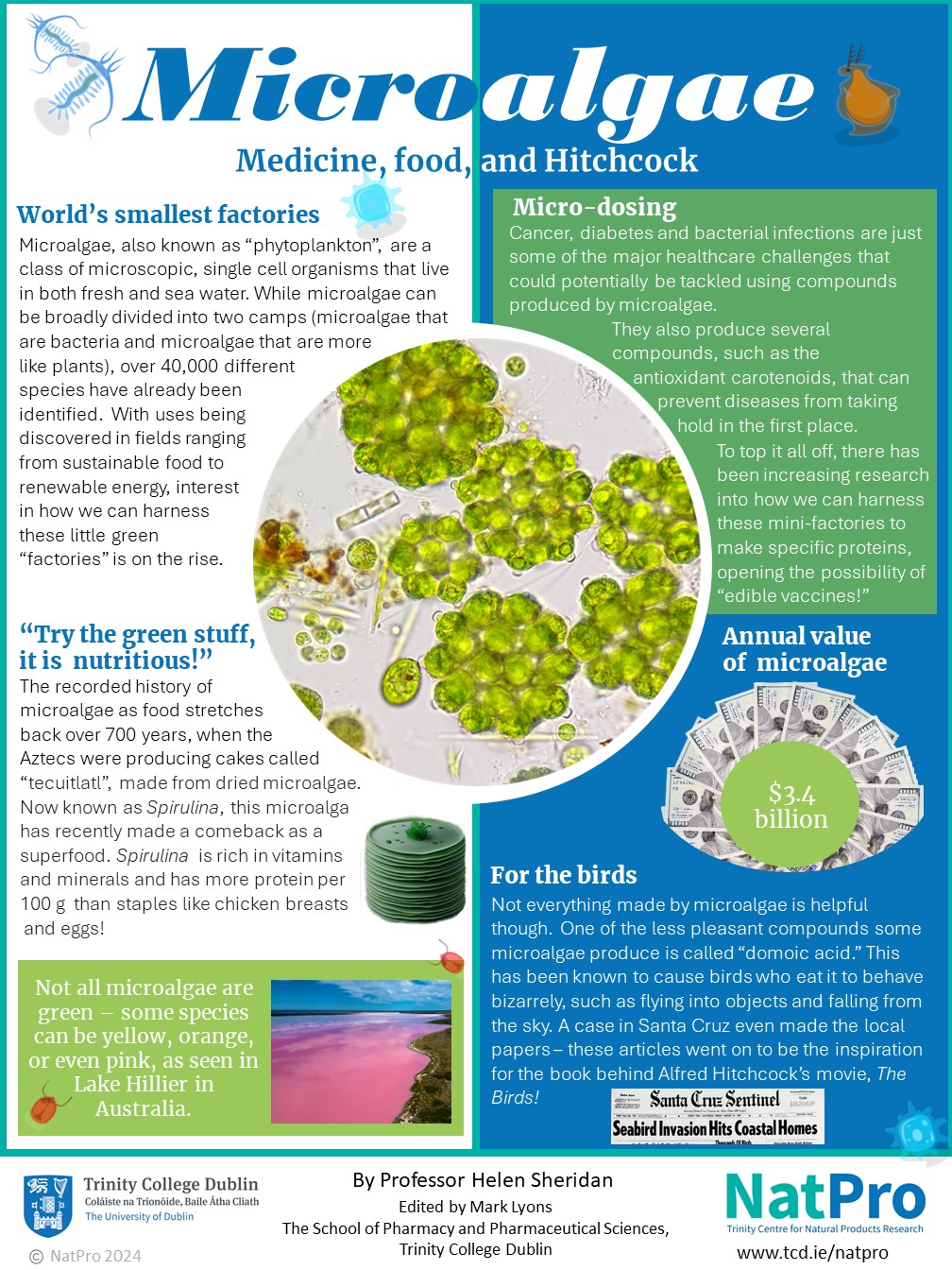
Helen Sheridan BSc, Professor in Pharmacognosy at Trinity College Dublin (TCD). Director of NatPro, Trinity Centre for Natural Products Research. With over 100 publications and €19 million in grants, she advances new therapies through interdisciplinary research in natural product chemistry.
Annual value source here
Image sources
- Image source of Bacchus Santa Cruz Sentinel Newspaper article 18th Aug 1961
Nature's Beauty
Theme Four
The fourth theme in our 'Nature's Treasure Trove' infographic series is 'Natural Beauty'! This captivating theme highlights the remarkable natural ingredients that have been cherished for centuries for their beauty-enhancing properties.
From the soothing aloe vera, revered since ancient times for its skin-healing benefits, to the versatile beeswax, celebrated for its anti-inflammatory properties and use in cosmetics, and the nourishing coconut oil, prized for its moisturising abilities in both skincare and haircare, we explore how nature's gifts have become integral to our beauty routines. Join us as we delve into these natural treasures and their enduring appeal in the world of beauty.
Aloe Vera - A succulent salve
Aloe vera, a succulent with a rich history, has been valued for its soothing and healing properties since ancient times. Originating in the Arabian Peninsula, it was used in Mesopotamia for its laxative effects and in Egypt and Greece for skincare. Today, its gel is celebrated for its ability to hydrate, heal, and soothe the skin.
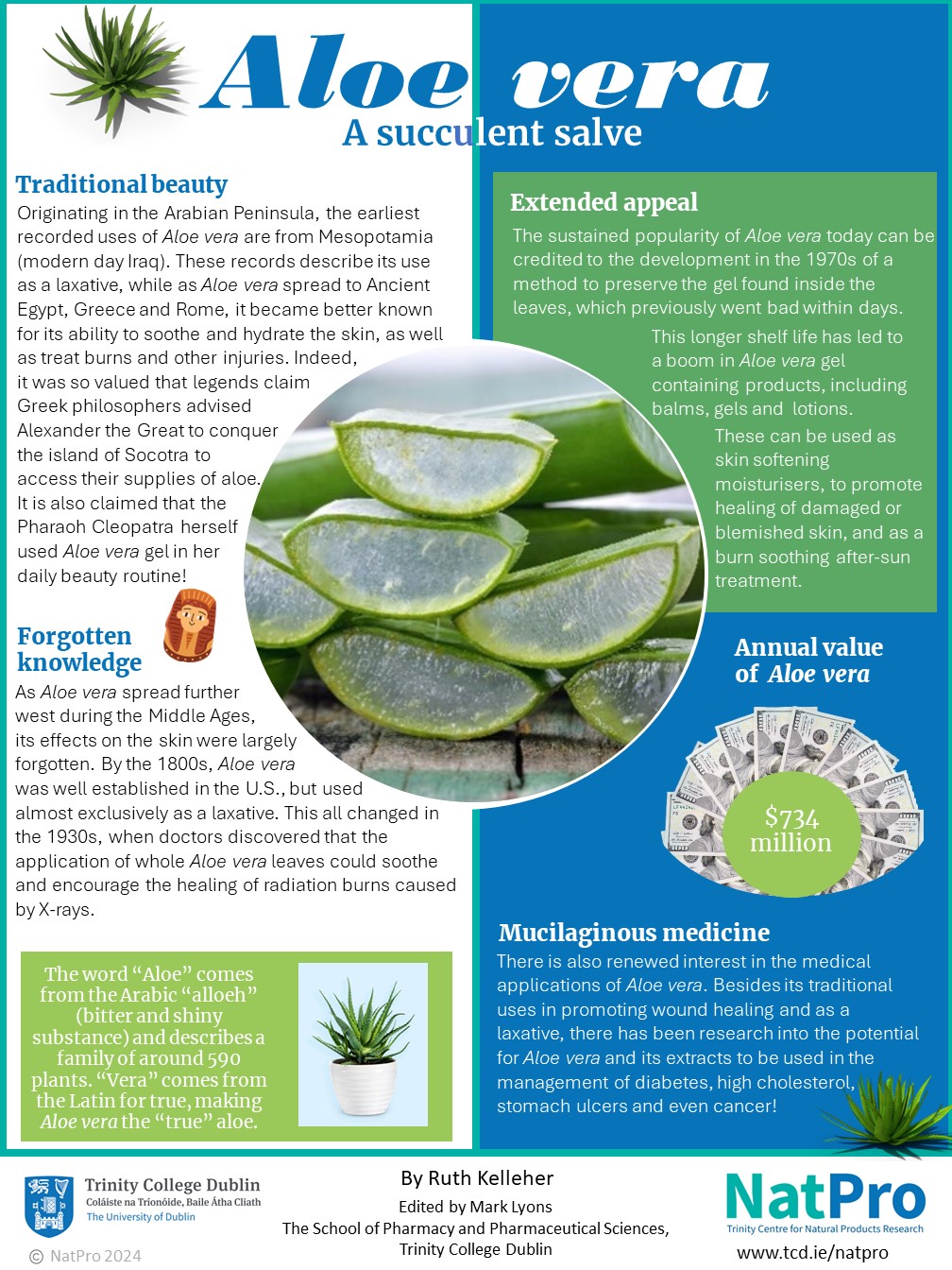
Annual value source here
Beeswax - Thank you to the bees
Beeswax, a natural marvel produced by honeybees, has been treasured for centuries. Initially white, it darkens to a golden hue and has been used since ancient Egypt for mummification and Roman times for moulds and candles. Today, beeswax is prized in cosmetics for its moisturising, skin-softening, and anti-inflammatory properties.
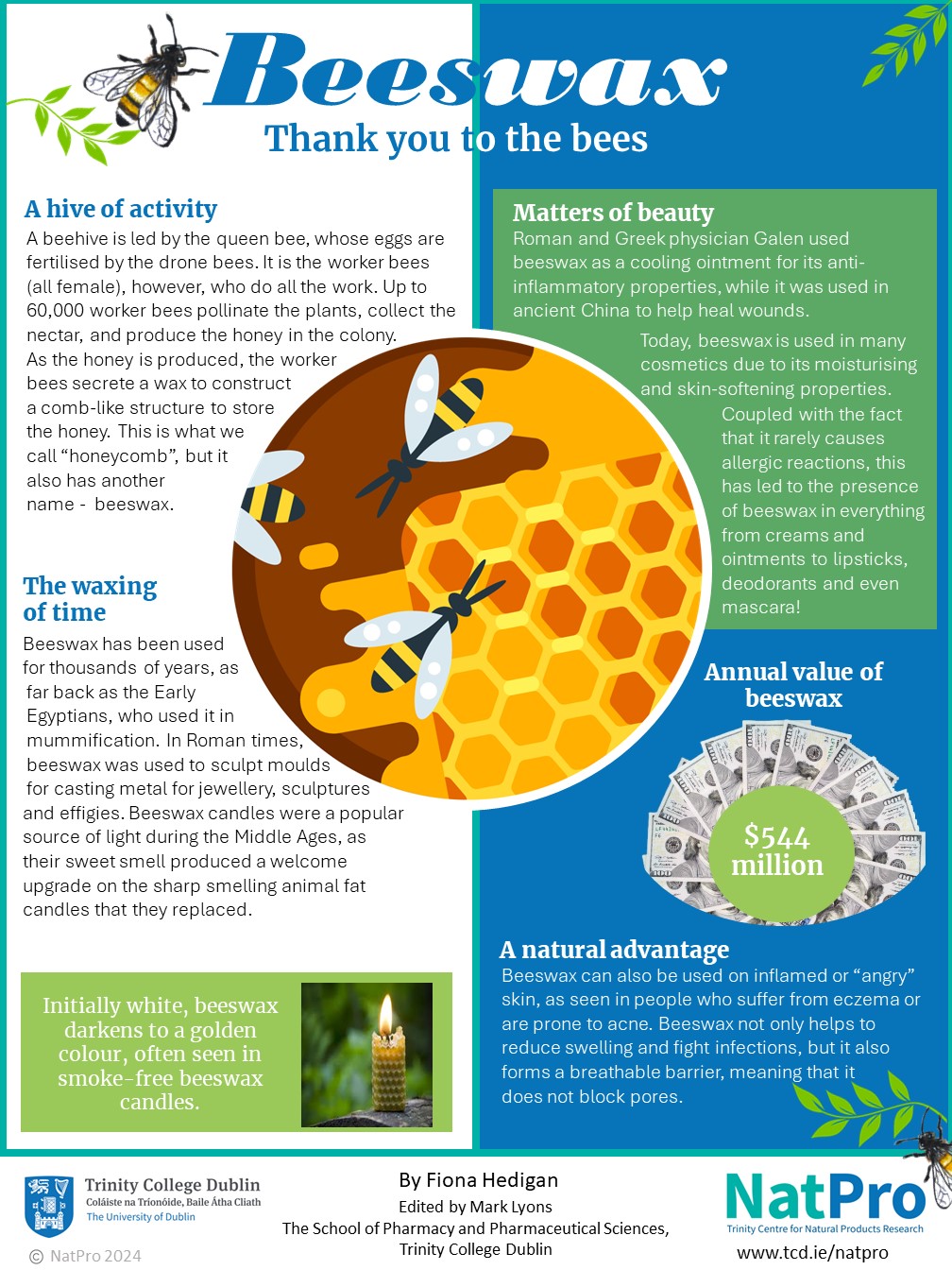
In 2020, Fiona Hedigan was awarded a scholarship from the Irish Research Council for a four year PhD to conduct research into the use of aromatherapy as a complementary treatment for stress and anxiety.
Hedigan's research is an exploration of the intricate biochemical interactions that unfold between the compounds inherent in essential oils and the receptors present within the human body and she recently published a paper titled ‘Benefit of inhalation aromatherapy as a complementary treatment for stress and anxiety in a clinical setting.’ Her research delves into the olfactory system, where the aromatic molecules in the oils trigger responses in the brain, and their potential impact on our emotions, stress levels and cognitive function.
Collaborating with experts in the medical and practical arena, she aims to bridge the gap between traditional knowledge and contemporary science. Her work is the embodiment of multidisciplinary research.
Annual value source here
Coconut oil - Oil from the tree of life
Coconut oil, extracted from the "tree of life," has been used for over 5,000 years. Originating in Southeast Asia and Oceania, it was essential in cooking and Ayurvedic health practices. Today, it's prized in cosmetics for its moisturising properties, benefiting hair and skin, although it can block pores.
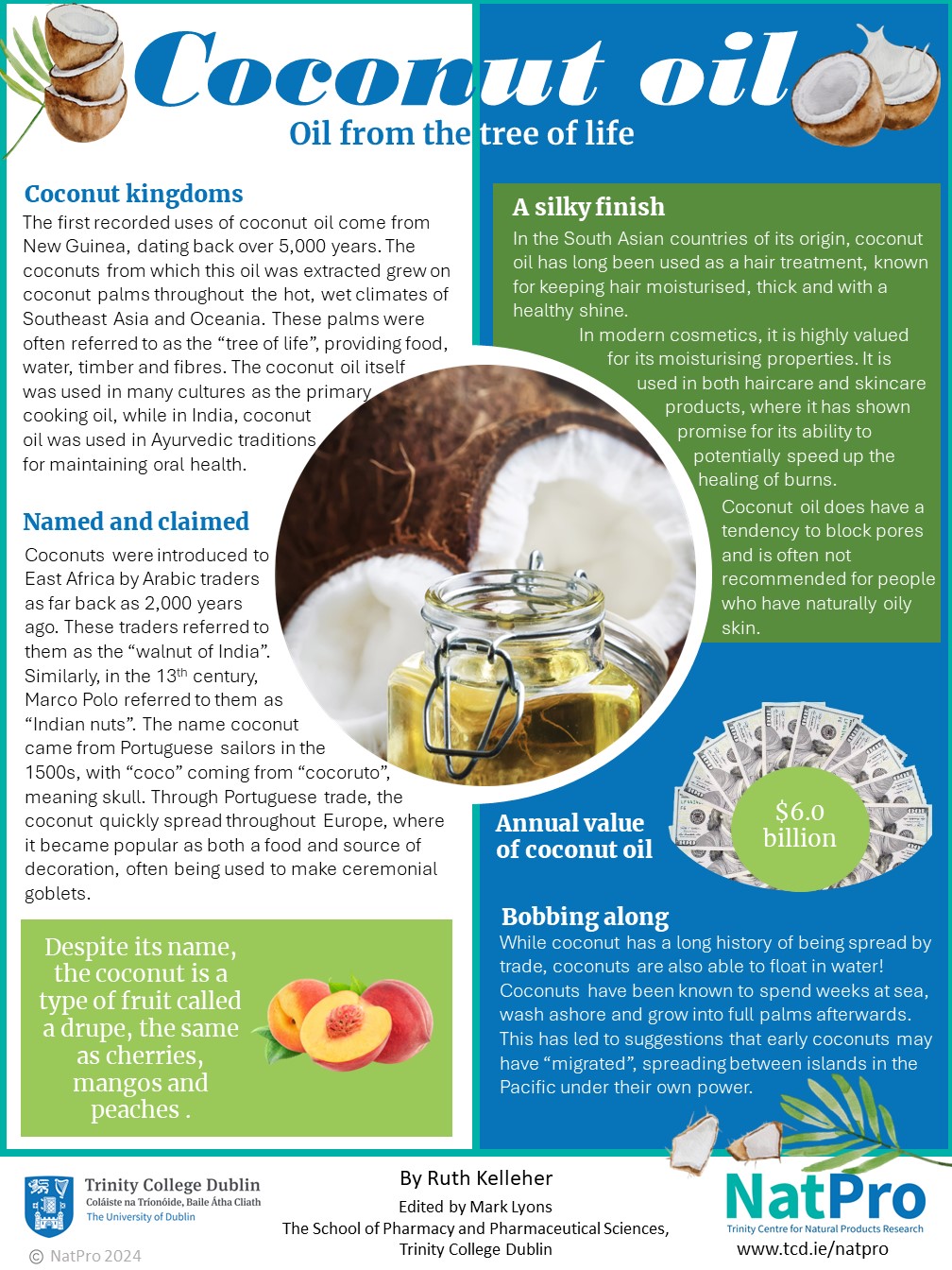
Annual value source here
Marvelous Materials
Theme Five
The fifth theme in our 'Nature's Treasure Trove' infographic series is 'Marvelous Materials'! This intriguing theme explores natural materials that have shaped human history and continue to revolutionise modern technology.
From the luxurious silk, valued for millennia and now finding new applications in medicine and technology, to the versatile latex, with its extensive uses from wound healing to bone regeneration, and the ubiquitous cotton, a staple in textiles with a rich history and broad utility, we uncover the incredible stories and ongoing innovations of these materials. Join us as we delve into the fascinating world of these marvellous materials and their enduring impact.
Cotton - The king of fibres
Cotton, often hailed as the "king of fibres," has a rich history stretching back over 5,000 years to the Indus River valley. Its resilience and versatility have made it a staple in textiles, from ancient garments to modern denim. Today, cotton continues to be a vital fabric, valued for its comfort, durability, and multifunctional uses in everything from clothing to homeware. Join us as we explore the remarkable journey and enduring significance of cotton in our 'Nature's Treasure Trove' infographic series.
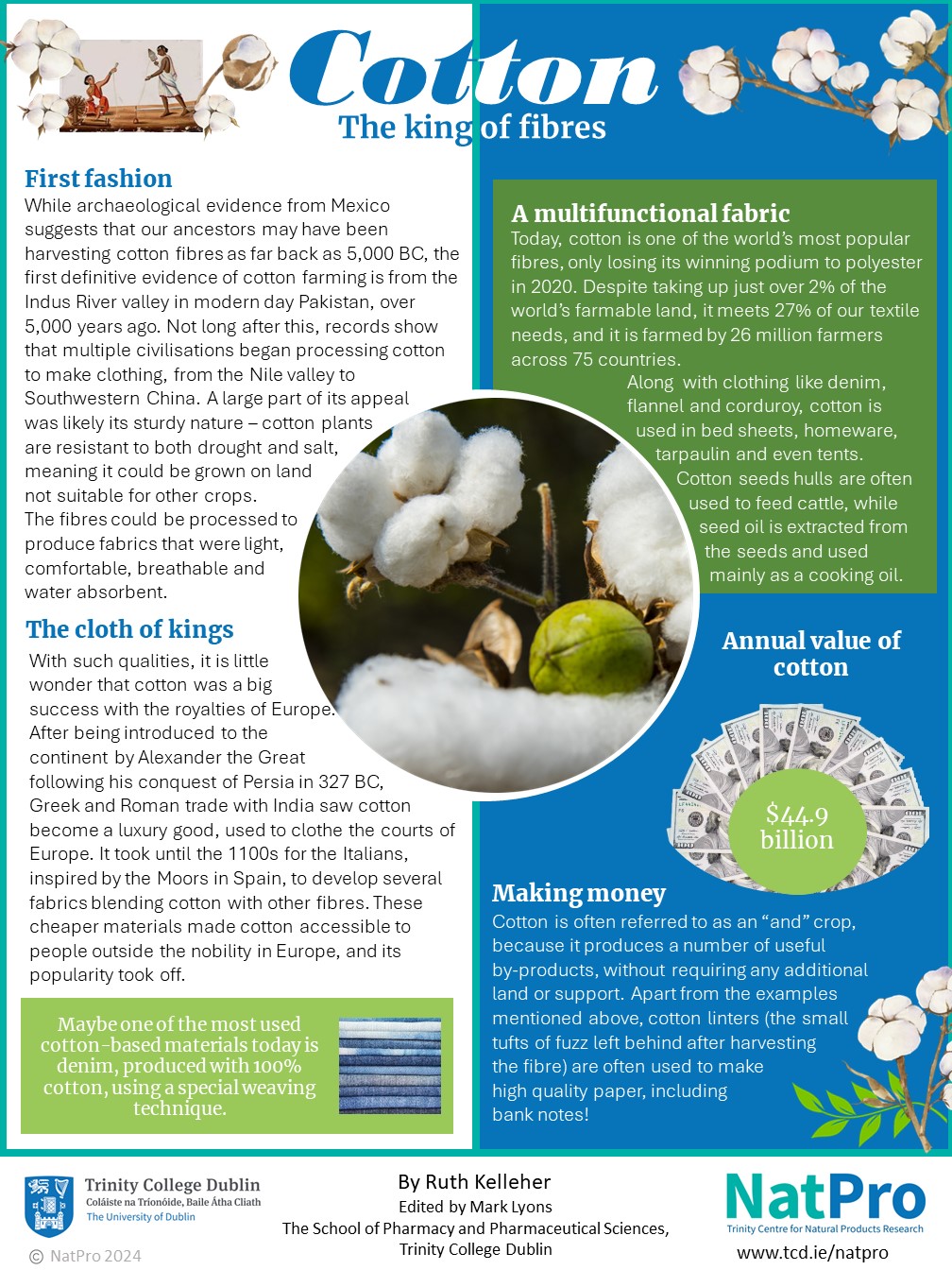
Annual value source here
Nature's silk - Unveiling high-tech potential
Silk, cherished for its luxurious texture and beauty, has been a symbol of opulence since its origins in China around 3,600 BC. Beyond its use in fashion, silk is now being explored for its innovative applications in medicine and technology. From ancient trade along the Silk Road to modern biomaterials, silk continues to captivate and inspire. Join us in our 'Nature's Treasure Trove' infographic series as we uncover the fascinating history and high-tech potential of this marvellous material.
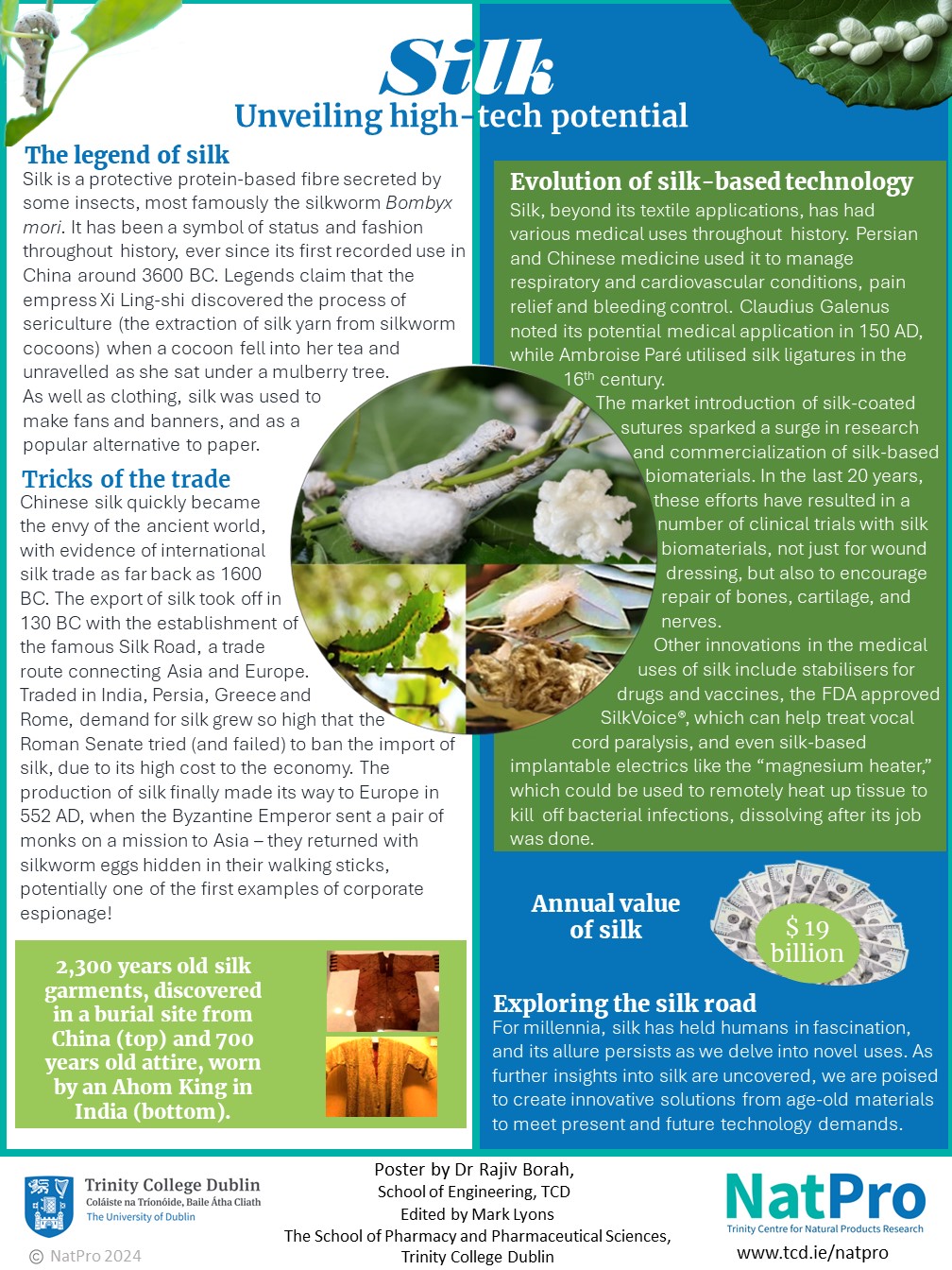
Dr Rajiv Borah primary research focuses on development of silk based injectable electroconductive hydrogel for spinal cord regeneration application. He obtained MSc (Nanoscience and Technology) in 2013 and Ph.D. in Physics (Materials Science) in 2018 from Tezpur University, India.
Annual value source here
Resin and Latex
Latex, a versatile natural substance, has been valued since ancient times for its wide range of applications. Originating from plant exudates, latex is used in everything from wound healing and bone regeneration to everyday products like gloves and balloons. Today, its antimicrobial and anti-inflammatory properties continue to make it indispensable in medicine and industry. Join us in our 'Nature's Treasure Trove' infographic series as we explore the fascinating history and modern uses of latex and resin.
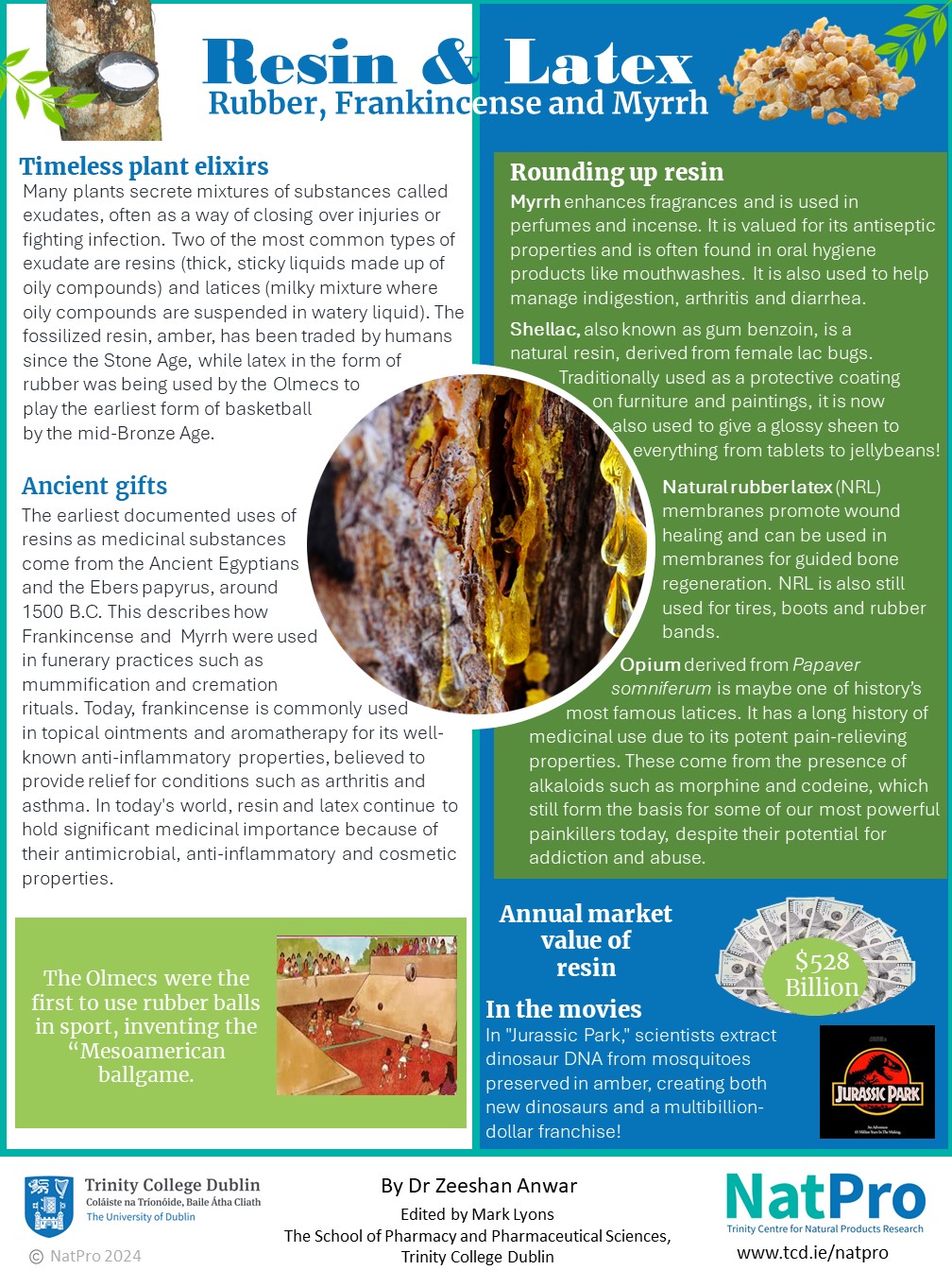
Annual value source here
Food for Thought
Theme six
The sixth theme in our 'Nature's Treasure Trove' infographic series is 'Food for Thought'! This theme delves into the fascinating world of natural ingredients that not only nourish us but also play vital roles in various industries and scientific advancements.
From soybeans, rich in protein and versatile in use, contributing to everything from tofu to biofuels, to cochineal, a tiny insect that produces a brilliant red dye used in food and cosmetics, and yeast, a microorganism essential in brewing, baking, and bio-pharmaceuticals, we explore the multifaceted benefits of these natural wonders. Join us as we uncover how these ingredients are integral to our daily lives and broader global innovations.
Soybean - The king of beans
Welcome to the world of soybeans, the versatile king of beans! Revered for over 3,000 years, soybeans have been a dietary staple and a source of innovation. From their origins in ancient China, where they were declared one of the "five sacred grains," soybeans have spread globally, becoming a key ingredient in diverse cuisines and modern industries. Whether it's tofu, soy sauce, or even biodiesel, soybeans are integral to our culinary and sustainable futures. Join us as we explore the incredible journey and multifaceted benefits of this remarkable legume in our 'Nature's Treasure Trove' series.
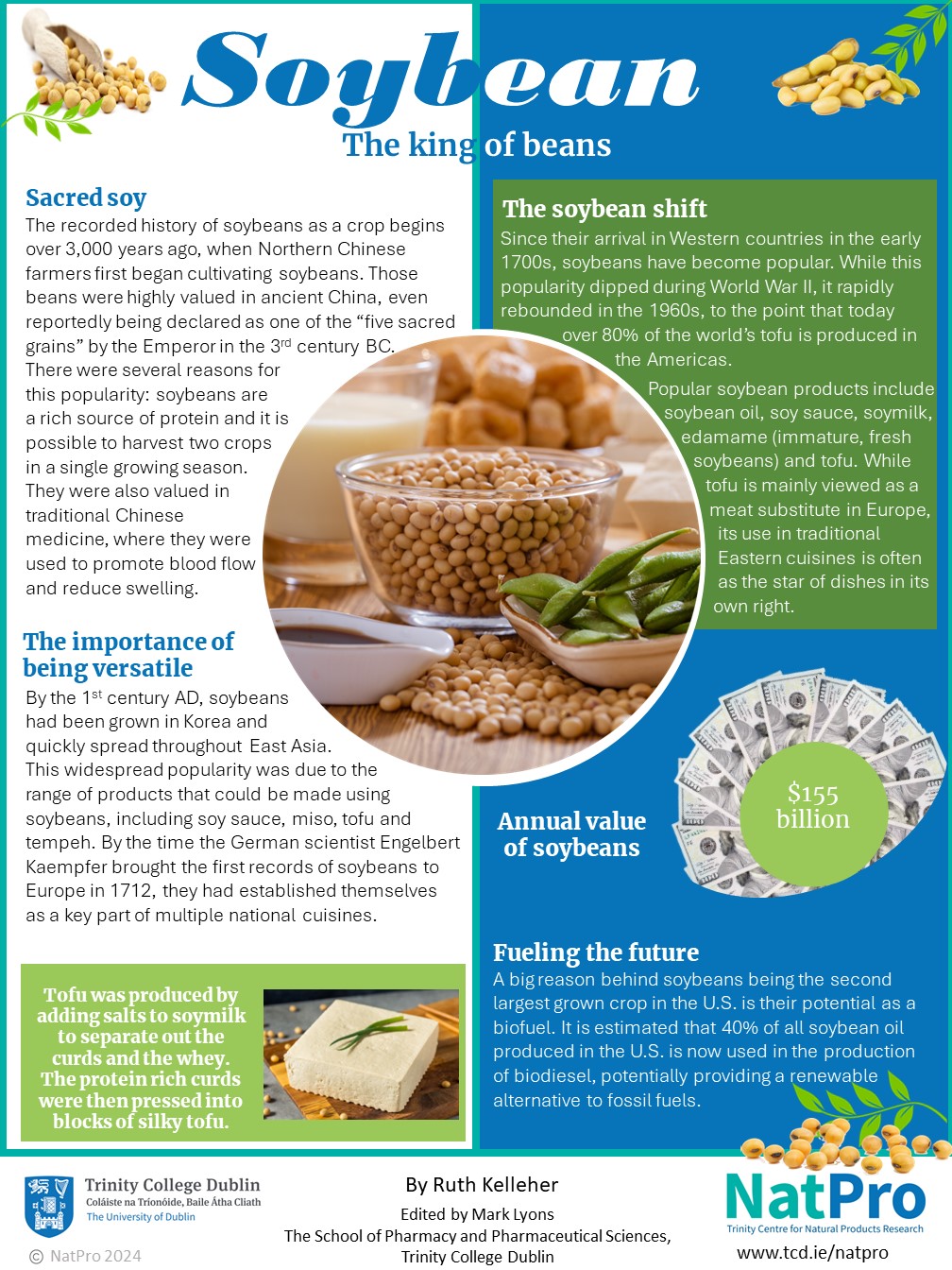
Annual value source here
Cochineal - A world in red
Welcome to the vibrant world of cochineal, nature's extraordinary source of red dye! Harvested from tiny insects found on prickly pear cacti, cochineal has been used since ancient Mesoamerica to produce the brilliant carmine red. This remarkable dye coloured the textiles and artworks of the Mayans and Aztecs and later captivated European royalty and artists. Today, cochineal continues to add vivid hues to food, cosmetics, and pharmaceuticals. Join us in our 'Nature's Treasure Trove' series as we delve into the fascinating history and enduring significance of this unique and powerful natural dye.
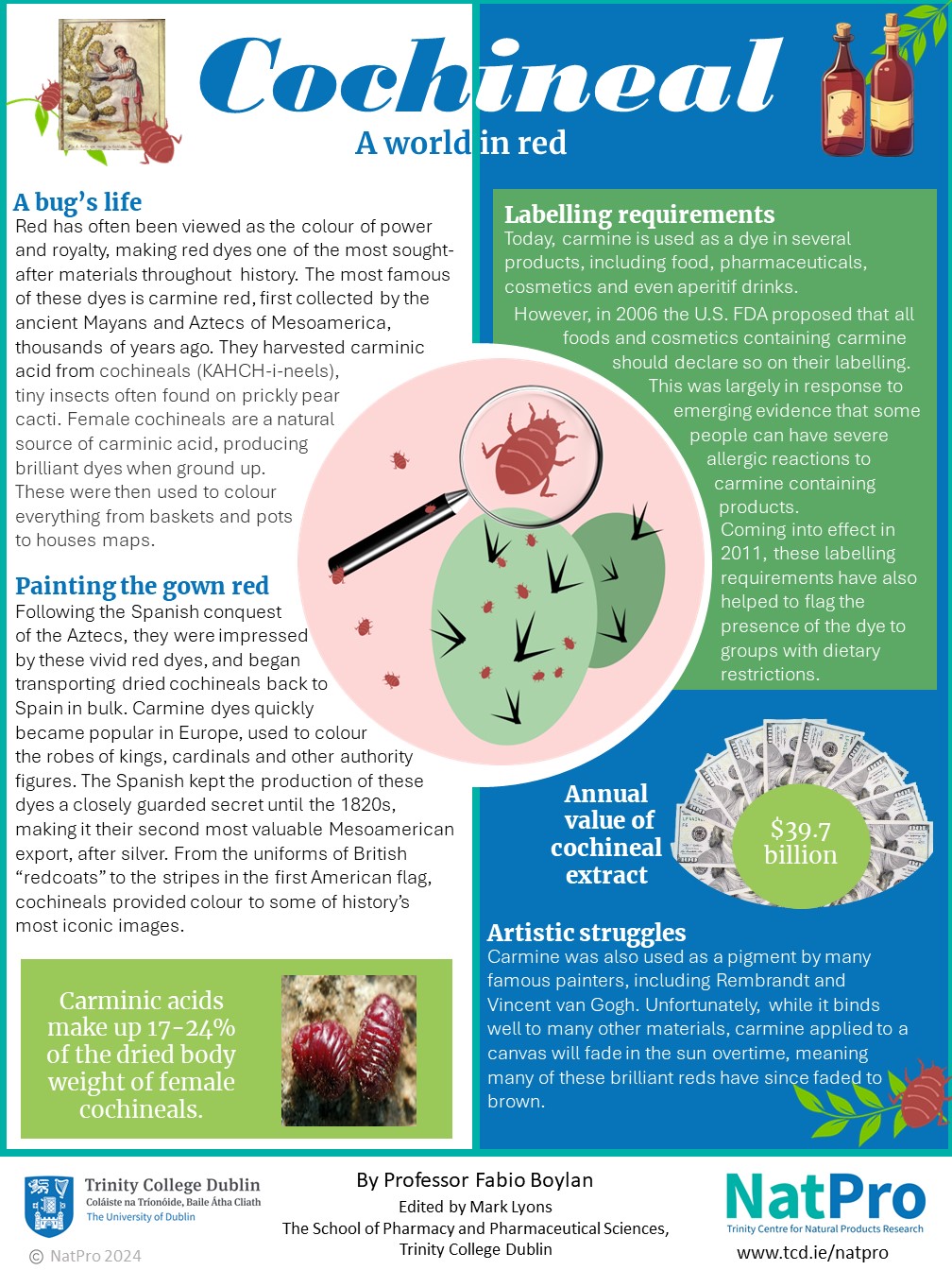
professor Fabio Boylan, Associate Acadaemic Director, NatPro, Associate Professor in Pharmacognosy, is a pharmacist with particular interest in the areas of ethnopharmacology (encompassing natural products isolation, analysis of herbal medicinal preparations and the validation of their pharmacological activities) and chemotaxonomic analysis. Transdisciplinarity is applied to his approach to teaching and researching. Currently Dr. Boylan is the Director for Global Engagement, International Liaison, and the Erasmus+ Coordinator with the School of Pharmacy and Pharmaceutical Sciences, TCD.
Annual value source here
- Image source from The Garden of Midgaard Mexican indian collecting cochineal with a deer’s tail” Ramirez 1777
Yeast - Beer, bread and beyond
Welcome to the fascinating world of yeast! This remarkable microorganism has been a cornerstone of human civilisation, transforming brewing and baking since ancient Mesopotamia and Egypt. Yeast's ability to convert sugars to alcohol and leaven bread has been harnessed for millennia, yet its potential reaches far beyond the kitchen. Today, yeast is pivotal in biofuel production, reducing our reliance on fossil fuels, and in biopharmaceuticals, producing essential medicines like insulin and vaccines. Join us as we explore the incredible journey of yeast, from ancient brewing vats to cutting-edge scientific innovations

Dr. Ursula Bond, a Fellow of Trinity College Dublin, graduated from TCD with a degree in Biochemistry and earned a PhD in Molecular Biology from Washington University, St Louis. She conducted post-doctoral research at Yale University before returning to TCD as an academic in the Department of Microbiology.
A world leader in industrial yeast genetics, Dr. Bond has published seminal papers and researched the genomes of Lager Yeasts, adaptive evolution, and RNA biogenesis in yeasts. She has secured 21 research grants, with funding totalling 15.67 million euros, and currently leads an EU Horizon 2020 project on yeast genetics and flavour production.
Annual value source here
Building a Bioeconomy
Theme seven
Welcome to our seventh theme of our 'Nature's Treasure Trove' series, focusing on 'Building a Bioeconomy.' Discover how natural materials like mushrooms, hemp, and biomass are driving sustainable growth and innovation. Mushrooms, hailed as the “food of the gods,” offer nutritional and medicinal benefits, including potential mental health treatments, while breaking down toxic waste and creating sustainable materials. Hemp, used for over 12,000 years, provides fibre, biofuel, and building materials, and is an effective carbon sink. Biomass, a renewable energy source since ancient times, is now upcycled into valuable products, from food to biofuel.
Join us to explore how these natural materials pave the way for a sustainable future.
Hemp - Rediscovering forgotten value
First used as a fibre in rope making 12,000 years ago, hemp went on to be used in one of the earliest forms of paper in Ancient China. It also became a key component in ship building, second only to timber in its importance. From the Vikings through to Christopher Columbus, hemp sails carried generations of sailors around the World. Despite being classified as containing less than 0.2% THC, hemp became a casualty of the war on drugs, with its cultivation banned across much of the World for much of the 1900’s. Only recently returning to the legal market, its wide usage across multiple industries has it poised to be one history’s great comeback kids.
Mushrooms - Mycelial magic
Continuing our 'Nature's Treasure Trove' series, we are burrowing into the kingdom of mushrooms, in conjunction with IKC3 - Ireland's Knowledge Centre for Carbon, Climate and Community Action, a project enabling transition to a low carbon economy.
With over 14,000 identified species, mushrooms are the celebrities of the fungal family. However, what we see is just the tip of the iceberg, with complex mycelial networks extending deep below the caps and stalks we know. Long valued as both food and medicine, mushrooms are now being used in a huge range of fields, from breaking down waste to producing materials like mycelium leather. Their ability to grow on the waste products of other industries gives them the potential to play a key role in a circular bioeconomy, while their untapped potential remains an inspiration across fields, be it in psilocybin based mental health research, or the spore drive engines in Star Trek: Discovery!
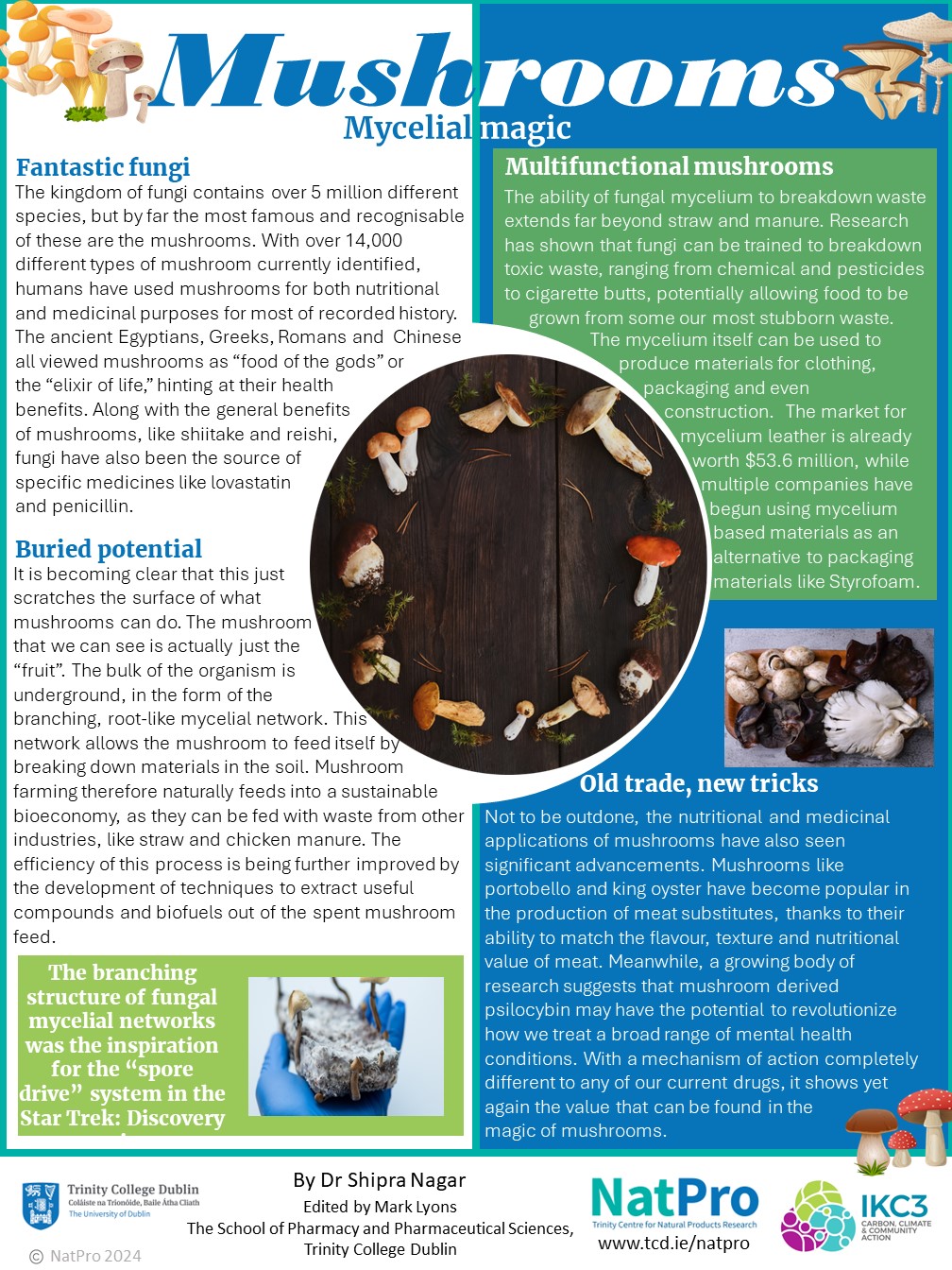
Annual value source here
Biomass - Fuel from the past, innovation for the future
Dating all the way back to the first fires, biomass has been used for energy through all of human history. After falling out of favour due to the rise of oil in the mid-19th Century, biomass is making a comeback, but as much more than just a source of renewable fuel. From brewer spent grain to banana peels, in food, energy, medicine and more, the ways that we generate new, sustainable value chains from our waste will go a long way to determining our success in building an effective bioeconomy.
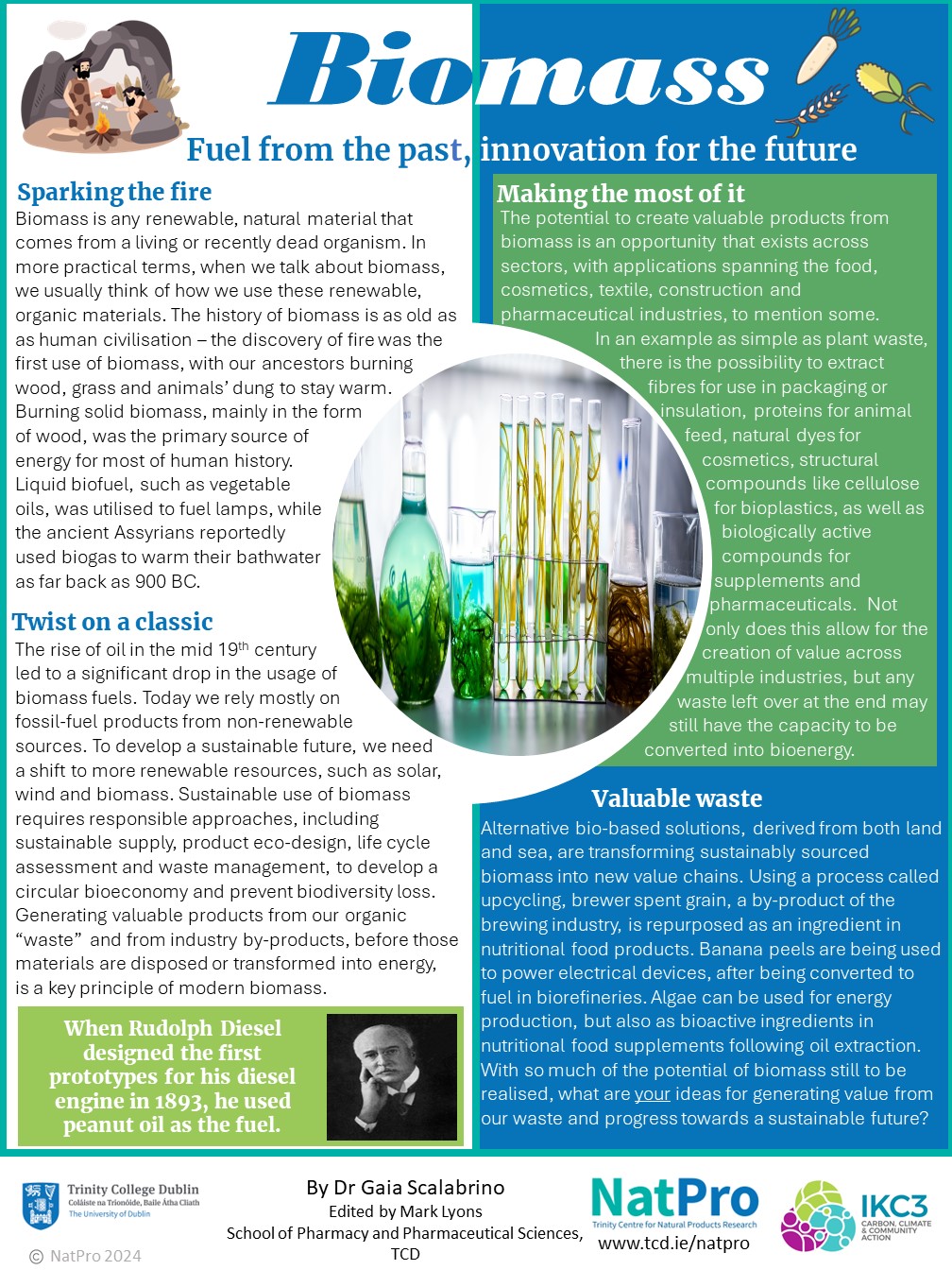
Annual value source here
Mind BOGgling
Theme eight
The eighth and final theme of our ‘Nature’s Treasure Trove’ series takes us back to our roots here at NatPro in Ireland, as we take a look at some ‘Mind BOGgling’ species found on Ireland’s boglands. Bogbean, often viewed as one of the most attractive wetland plants due to its distinctive white flowers, has been used in a range of cosmetics due to its anti-inflammatory and antioxidant properties. Bog myrtle was once one of the main ingredients used to flavour beer, prior to the introduction of hops. Along with continued use in gin production, bog myrtle is also used as a natural insect repellent. Moss, perhaps the most known of all, is often referred to as the ‘bog builder’, with absorbent and pH lowering properties that allow it to give structure and life to our bogland ecosystems. This also made it an excellent material for wound dressings, as it was used in both World War I and II. Join us as we explore the ‘Mind BOGgling’ value and opportunity that our boglands hold.
Bogbean - Multipurpose marvel of the mire
Instantly recognisable by its distinctive white flowers, bogbean is an ancient plant found across the wetlands of the northern hemisphere. It is particularly prominent in the bogs of Ireland, where it is known as Báchrán and is still in use across the country as a decorative plant and in the flavouring of the spirit poitín. Traditionally employed to treat a range of conditions, including scurvy, indigestion and arthritis, modern research has revealed that this plant does indeed contain a number of compounds with antioxidant and anti-inflammatory potential. On top of a range of health supplements, bogbean is also used in cosmetics, textile dyes and brewing.
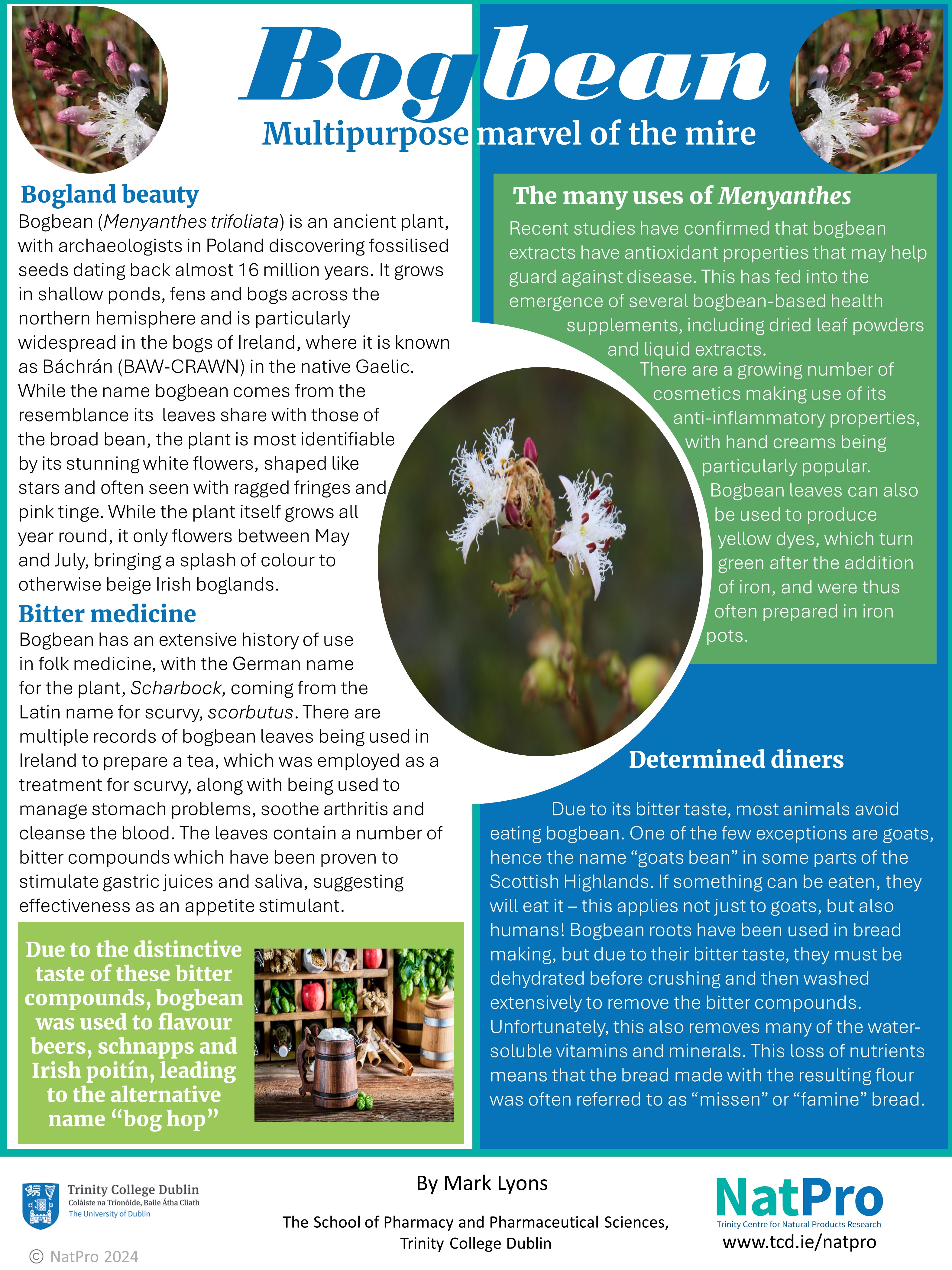
By Mark Lyons
Bog Myrtle - Bugs, balms, and brewing
Most easily identifiable by its strong, grassy scent, bog myrtle has long attracted people and repelled insects. Its leaves were traditionally used to ward against all manner of small creatures, both as an insect repellent and an antiseptic essential oil. Once a cornerstone of the brewing industry before the rise of hops, the commercial value and potential of bog myrtle remains clear, from its role in the cut flower market to its presence in numerous Irish gins.

By Shipra Nagar
Moss - Sensational Sphagnum
Blanketing the surface of bogs and peatlands across Ireland, sphagnum moss is one of the major contributors to the unique soil conditions of our boglands. Able to hold over 20 times its weight in water, sphagnum moss keeps bogs wet year round, while also helping to maintain a low pH. Famed for its antimicrobial properties in wound dressings since the Battle of Clontarf, sphagnum moss was a staple in medical kits during both World Wars. These same antimicrobial properties prevent the breakdown and release of carbon in bogs, making them incredibly efficient sinks – despite only covering 3% of the planet’s surface, boglands contain almost a third of all soil based organic carbon, giving them a key role in building towards a sustainable future.
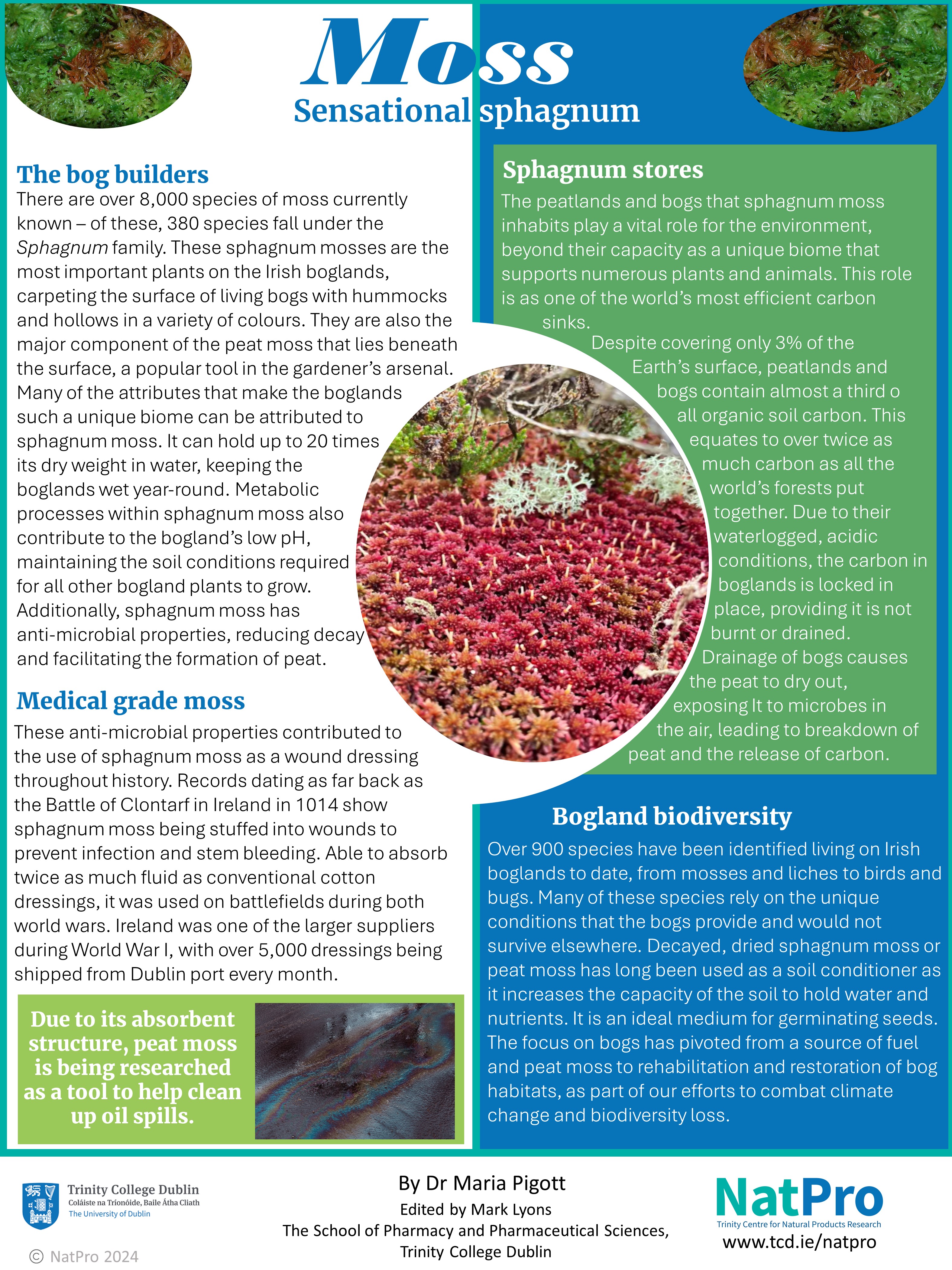
By Maria Pigott
About the editor, Mark Lyons
 Mark Lyons is a Panoz Pharmaceutical Innovation PhD Scholar, currently in the third year of his PhD at the School of Pharmacy and Pharmaceutical Science at Trinity College Dublin. He completed his undergraduate in the school of Pharmacy at Trinity in 2021 and is a registered pharmacist. Mark is a board member of SciFest, the charity responsible for running Ireland’s largest set of STEM fairs for secondary school students. He has judged at a number of STEM competitions, including the national finals of the SciFest and Intel Mini Scientist competitions, along with presenting at events such as Pint of Science. Mark’s research is focused on developing novel chemotherapies from natural products, and he recently published his first literature review on the potential of fungi in the development of new cancer treatments, in the Journal of Natural Products. Mark has a strong belief in the importance of science communication and the value of providing opportunities for people to engage in science at all levels.
Mark Lyons is a Panoz Pharmaceutical Innovation PhD Scholar, currently in the third year of his PhD at the School of Pharmacy and Pharmaceutical Science at Trinity College Dublin. He completed his undergraduate in the school of Pharmacy at Trinity in 2021 and is a registered pharmacist. Mark is a board member of SciFest, the charity responsible for running Ireland’s largest set of STEM fairs for secondary school students. He has judged at a number of STEM competitions, including the national finals of the SciFest and Intel Mini Scientist competitions, along with presenting at events such as Pint of Science. Mark’s research is focused on developing novel chemotherapies from natural products, and he recently published his first literature review on the potential of fungi in the development of new cancer treatments, in the Journal of Natural Products. Mark has a strong belief in the importance of science communication and the value of providing opportunities for people to engage in science at all levels.


